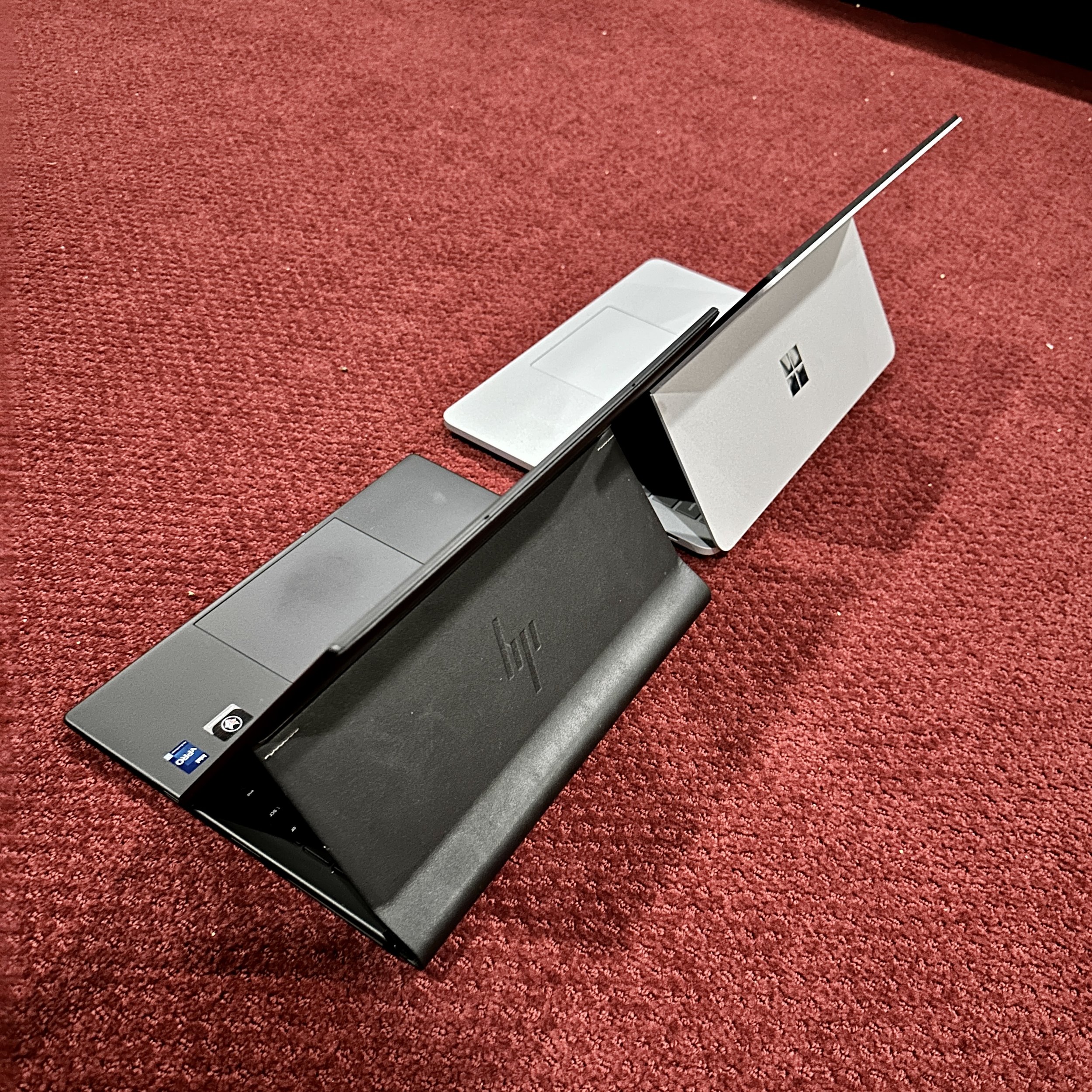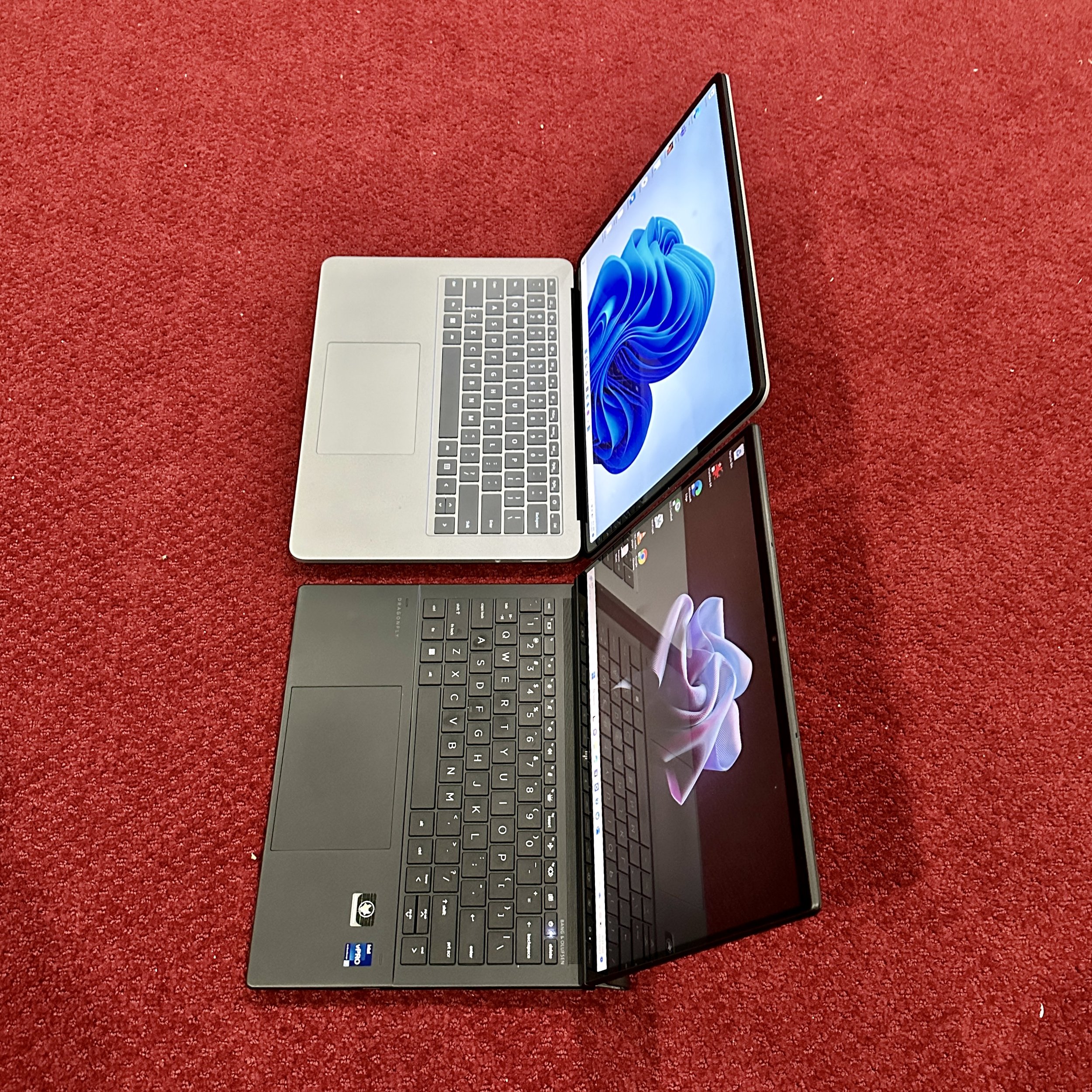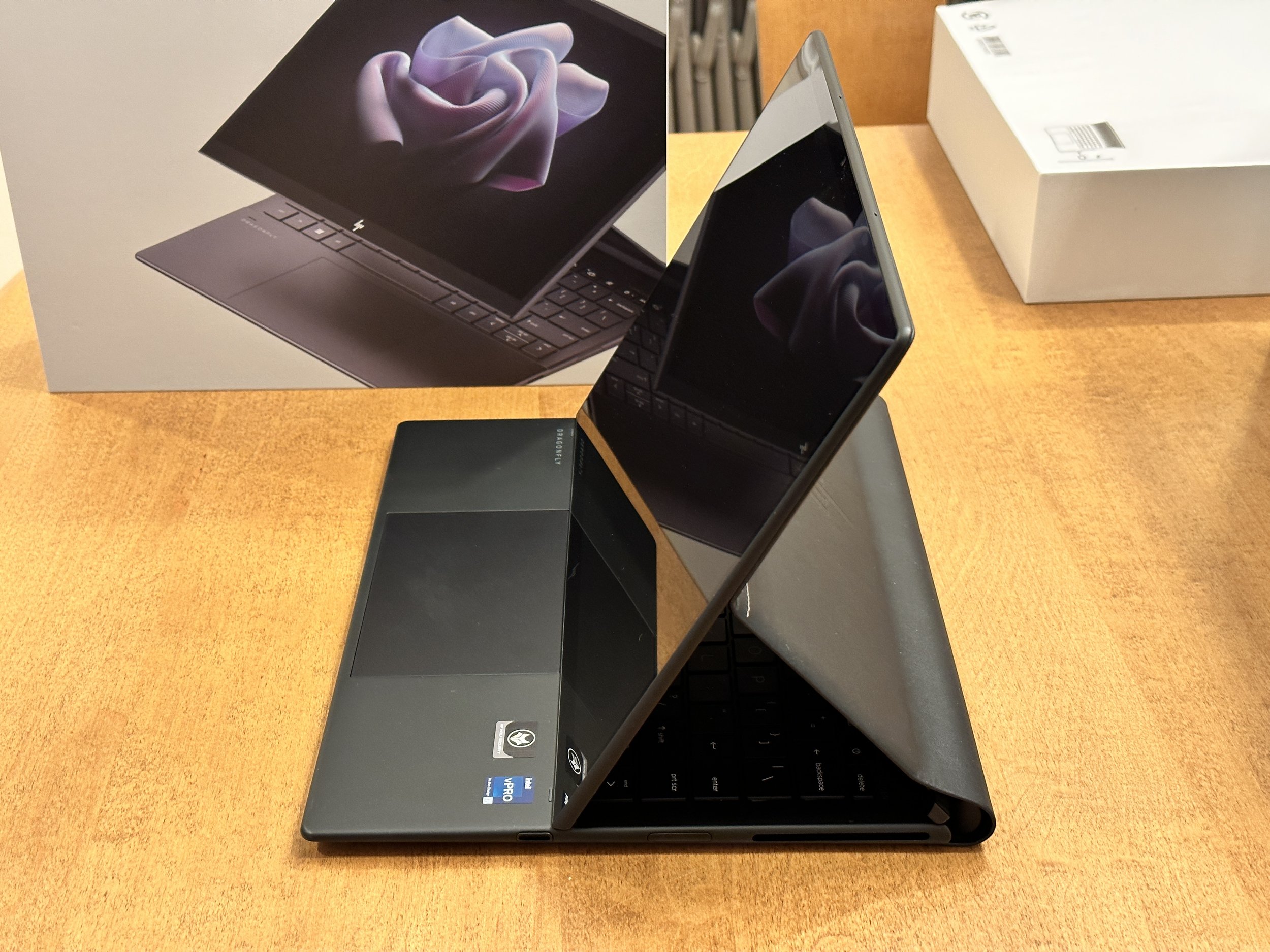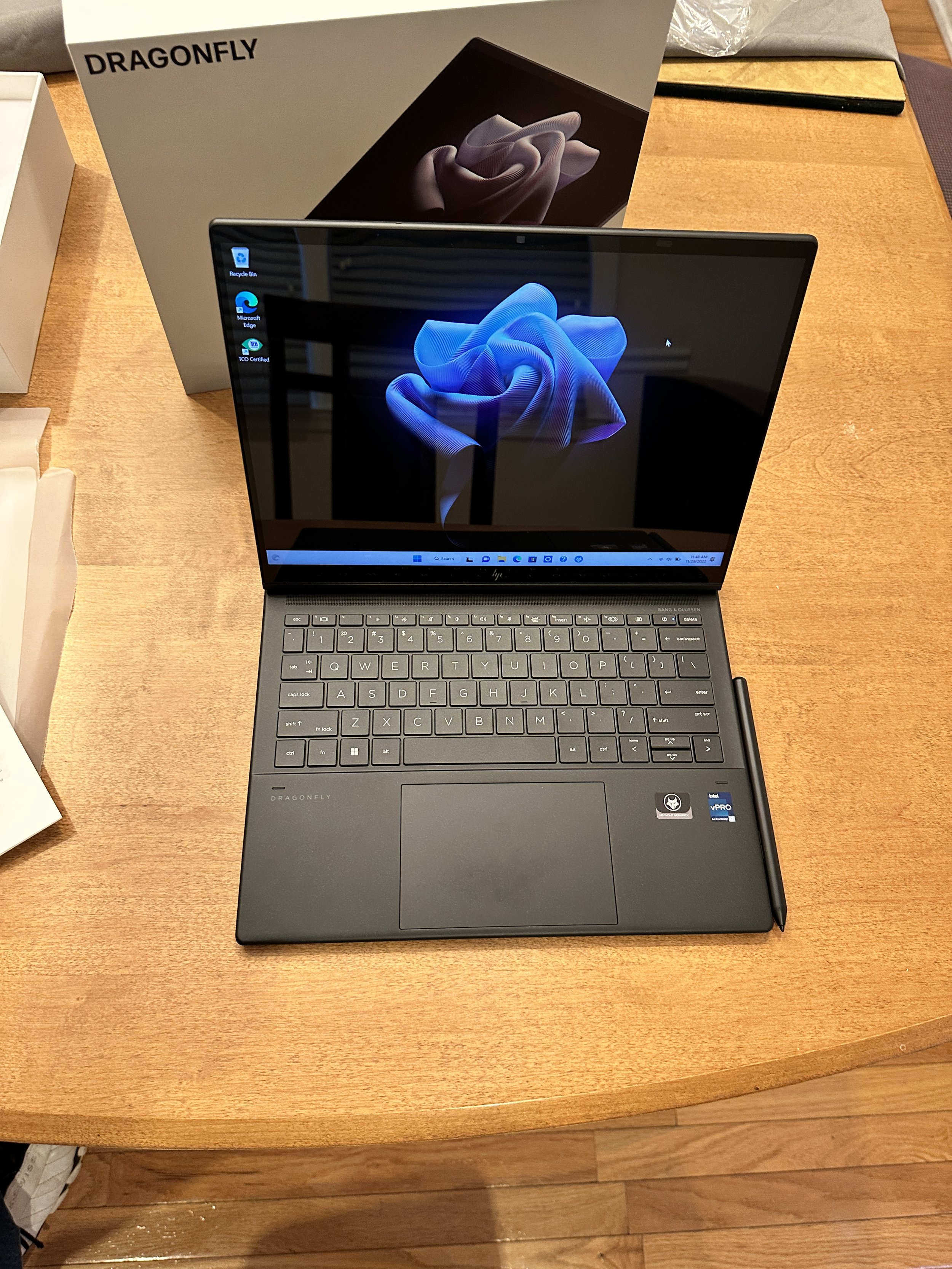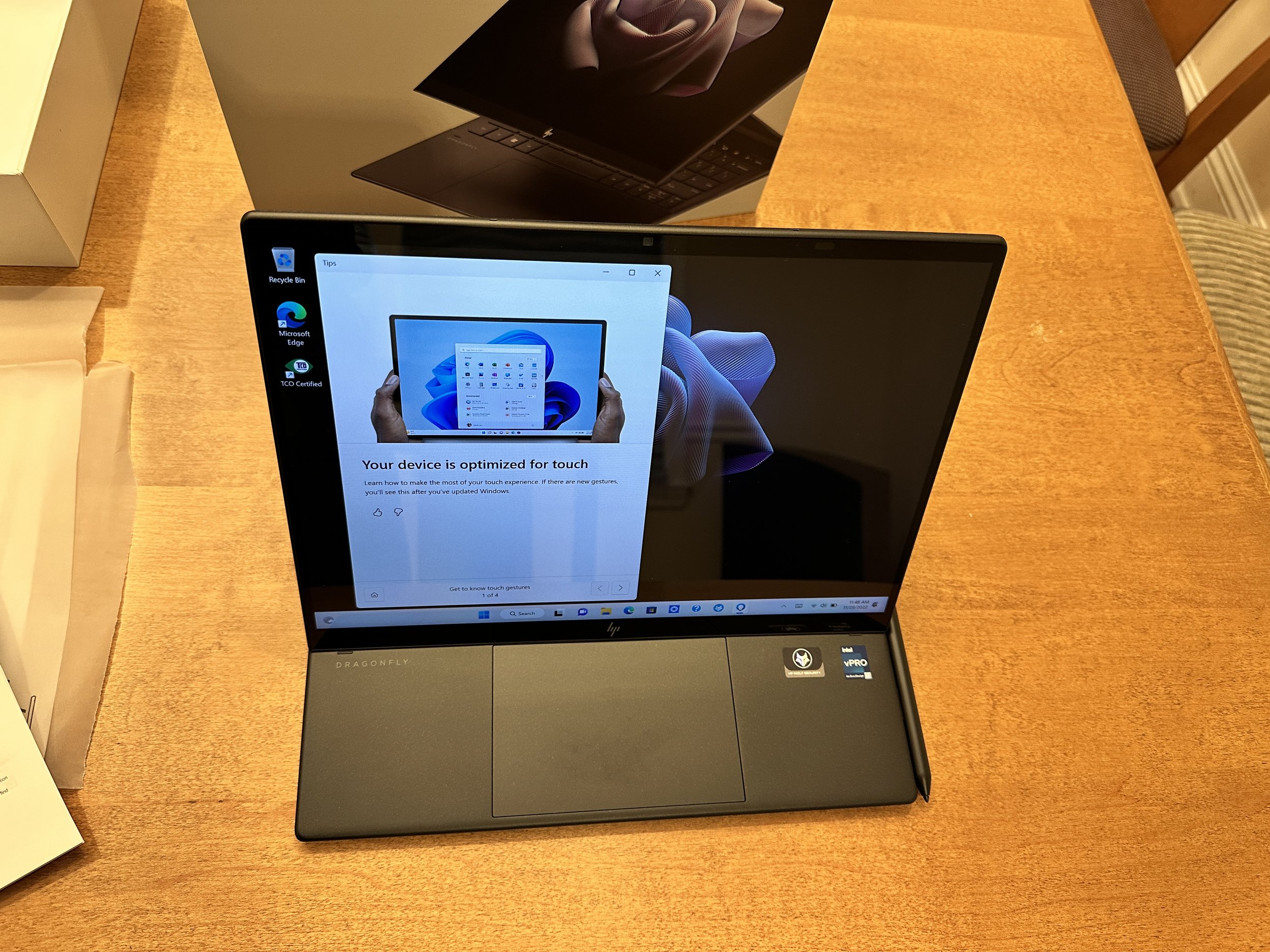HP’s Dragonfly Folio G3 is Everything Right – and Wrong – with the Windows Ecosystem
HP’s Dragonfly Folio G3 represents everything that the Windows ecosystem does well – flexible form factors and display options, touch and pen input, WWAN connectivity – and poorly – x86 performance/battery life relative to Apple Silicon, pricing power, and channel/branding issues.
Introduction
At first glance, HP’s Dragonfly Folio G3 looks like a regular 13.5” laptop that someone partially wrapped in leather. The cover isn’t actually leather, and also is nowhere near the most interesting aspect of the device. HP stuck a hinge about halfway down the back of the 3:2 display, and the bottom of the display is attached by magnets. With a light push to disengage the magnets, the screen swings forward in front of the keyboard and can dock there for watching content. Push the display down further and it sits nearly flat, angled slightly towards the user for use as a thick, heavy tablet or as a perfectly positioned drawing slate.
The form factor and ergonomics are delightful for personal and professional productivity, and HP is charging accordingly. While the Dragonfly Folio G3 is extremely expensive at launch, HP doesn’t have much long term pricing power (more on this below), and I can easily recommend buying one, especially when it inevitably goes on sale. When I wrote this section my review unit was listed on HP.com for $2,749; that includes the highest end 12th gen Intel Core i7 U-series processor, 16GB DDR5 RAM, 512GB SSD, Wi-Fi 6E and MediaTek-based 5G. However, when HP sent it last month it was listed for $300 less, and there are plenty of less expensive configurations.
Microsoft’s Surface Strategy is Working
The Dragonfly Folio G3’s pull-forward form factor owes a debt to Microsoft’s Surface line, specifically, the Surface Laptop Studio. The Dragonfly Folio G3 has a more rounded silhouette and a more secure-feeling hinge mechanism, but in terms of overall design concept, it is clear where HP got the idea. Microsoft is likely thrilled.
When Microsoft launched the Surface RT and Surface Pro back in 2012, there were questions as to why the company was willing to compete with its Windows licensees. I spoke to Microsoft about this at the time, and while they fully intended to build a business around PC hardware, the strategy was to push the envelope on form factors and use cases while ensuring that the Windows ecosystem would have premium design options. This strategy – and Microsoft’s patient execution of it – has proven itself. While Lenovo has long been willing to experiment with wild one-off Windows devices (Yoga Book anyone?), that’s actually the problem: one-off devices aren’t enough to ensure a healthy device landscape. Microsoft can afford not only to try new device form factors, but also to refine them to the point where they are successful (ex: Surface Pro) or at least prove that the idea probably isn’t going to benefit from further investment (ex: Surface Book). At that point, if other Windows licensees pick up the winners and run with them, that benefits Microsoft as a whole, even if the Surface device in question has more competition.
Ironically, the Surface Laptop Studio is only a single generation old, and HP’s implementation of the pull-forward design is arguably better than Microsoft’s own. The hinge design feels more secure, and the overall weight is significantly lower, making it more portable (I’m writing this paragraph on the Dragonfly Folio G3 in the waiting room at my kid’s doctor’s office). Microsoft does offer the Surface Laptop Studio with discrete graphics making it a better fit for those who need more of a plugged-in workstation/Wacom combination; for that reason, HP doesn’t consider the Surface Laptop Studio a direct competitor to the Dragonfly Folio G3. Microsoft might disagree with that assessment, but it should be happy that the Dragonfly Folio G3 exists for the broader ecosystem.
The Best of Windows
Even if you never pull it forward or down, the 13.5” 400 nit display is a pleasure to work on, in part because of the 3:2 aspect ratio that lets you see more of your content in addition to app toolbars. This is another debt owed to Microsoft’s Surface line, which popularized this aspect ratio. The Dragonfly Folio G3’s display resolution is only 1080p, but it appears sharper and is bright enough for work in any indoor environment. HP also offers an optional 1080p 1000 nit privacy display for those working on sensitive documents. For those who want something with higher resolution and contrast, HP also offers a 3K x 2K OLED, but has chosen to only make this available through business distribution channels (not even HP.com), which is a shame. If I wasn’t concerned about battery life driving the higher resolution display, I would ask HP to send over that model, because pulling the screen forward and watching movies is a core use case.
Unlike Macs, Windows supports both touchscreen and pen input, and the HP Dragonfly Folio G3 makes full use of both. Touch in Windows is more of a supplement than a main input method, but it’s extremely nice to have. Pen in Windows can be a game changer for those who frequently sign or mark up documents, and for anyone doing art or design. However, the traditional laptop form factor makes pen use silly, and even convertibles add so much friction to the experience that it isn’t worth using for anything other than a full-on drawing session. The Dragonfly Folio G3’s pull-forward-and-down form factor means that you switch modes instantly to sign, annotate, or draw without disrupting your workflow. HP further enhances Pen usability by providing a side berth with a strong magnet holding it next to a wireless charging area. While not as secure as an internal storage bay, the pen is always nearby and fully charged.
There are a slew of privacy and collaboration features. HP includes an 8MP webcam that’s genuinely good and can be disabled with a button on the keyboard. The camera is complemented by dynamic voice leveling microphones that magically make the speaker sound the same no matter where they are in the room. The laptop also locks the screen when you step away, and unlocks automatically when you return, which is both a security and a convenience feature.
Input and output ergonomics are good. The keyboard has snappy travel and the large trackpad is responsive without palm rejection problems or errant inputs. HP also has a dedicated macro button on the keyboard that can jump to an app, website, file, or folder. The speakers are reasonably loud and clear, and the acoustics adjust when you pull the display forward. If you have wired headphones, HP thoughtfully includes a 3.5mm headphone jack. I would have appreciated more ports; while I appreciate that the Pen and fan vents eat up a lot of the side real estate, the two USB-C Thunderbolt ports are the bare minimum.
Unlike any Mac, the Dragonfly Folio G3 can be optioned with a MediaTek-based 5G modem and both physical SIM and eSIM slots, greatly simplifying connectivity. Cellular connectivity is also an effective security measure, avoiding sketchy or spoofed Wi-Fi hotspots. The physical SIM slot even pops out without a tool.
The Dragonfly Folio G3 weighs just over 3 lbs, which is not as light as HP’s 2.2 Dragonfly, but is still highly portable given all the tech and form factor considerations. It helps that the rounded teardrop shape and leather-like polyurethane cover of the Dragonfly Folio G3 make it extremely comfortable to carry.
While battery life is just acceptable (see below), HP makes the most of the silicon it has. The Dragonfly Folio G3 fans are incredibly quiet – in anything other than a perfectly silent room they are inaudible. Benchmark tests suggest HP’s thermals allow it to run faster longer than rivals using the same Intel U-series processors, and the laptop never got hot on my lap. I also had no issues with losing battery life during sleep – the Dragonfly Folio G3 puts itself into hibernation mode when you leave it sleeping too long.
…And The Worst of Windows
I have used both Windows and Macs for years, and while Apple had a significant usability advantage two decades ago, Microsoft has long since caught up. At this point, for most users, the OS is more a matter of preference and muscle memory rather than a dramatic competitive differentiator. The same cannot be said for silicon. Apple Silicon gives Macs a significant advantage in battery life, heat, and performance.
The Dragonfly Folio G3 features an ultraportable chipset with integrated Iris Xe graphics, and given those constraints, it performs well. I encountered no processor (or memory, or SSD) slowdowns that impacted my productivity workload, no matter how many Word docs, browser tabs, or videoconferencing sessions I Alt-Tab’d between. However, I did not try to play AAA games, edit long videos, or do 3D design. A similarly priced MacBook Pro M2 will be able to take on significantly heavier workloads for hours longer.
HP lists the Dragonfly Folio G3’s 53Wh battery life at 12 hours of video playback, and claims that this is a good measurement because it is easily replicable across devices. That may be true, but nobody buys a $2500+ laptop to watch looped video. In my actual mixed use of Office, web, social media, video calls, and basic imaging I typically got just over 5 hours on battery power before the laptop died. Based on other reviews I’ve seen, it should be possible to extend that out another hour or two by keeping the cellular modem off and cutting screen brightness, but my experience isn’t that much of an outlier. Qualcomm offers Arm-based processors for Windows which offer long battery life, and that segment of the ecosystem is improving rapidly, but performance and app compatibility remain a concern. Apple is well ahead of Intel and Microsoft on real world performance/efficiency tradeoffs.
Finally, while Microsoft has done a good job maintaining premium positioning and pricing on its Surface line, its Windows licensees haven’t. I initially had trouble finding the HP Dragonfly Folio G3 on HP’s website and that the price kept changing during the time I wrote this review. The pricing issue is endemic to premium Windows laptops: none of the OEMs seem to have much pricing power, and high-end Lenovo and Dell laptops also frequently drop by hundreds of dollars from their launch prices.
Windows OEMs also seem to think that enterprises will pay a premium for portability or power, but consumers won’t. Apple has been delighted to prove them wrong. Repeatedly. For decades.
HP classifies the Dragonfly Folio G3 as a business machine, which not only means that it has beefier security software and Intel’s vPro processor, but it also only gets listed in the business section of the website and is distributed in corporate retail channels. The Dragonfly Folio G3 is a great laptop, maybe an ideal one for pen-centric content creation and watching movies on the pull-forward display. But good luck buying one at Best Buy; it’s not sold there. You can buy one on HP.com, but don’t click on PCs > Laptops because it won’t appear in those listings; you need to bypass “Laptops,” and scroll down to “Business Laptops.” However, even then the Dragonfly Folio G3 isn’t treated as a hero product on the site. You also won’t be able to configure a Dragonfly Folio G3 with an OLED display option on HP’s site because …I still haven’t figured out a rationale for that one. If you want one, you’ll need to open an account with CDW or Ingram Micro. If you aren’t a corporation, good luck with that.
To discuss the implications of this report on your business, product, or investment strategies, contact Techsponential at avi@techsponential.com or +1 (201) 677-8284.


